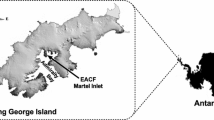Abstract
Rainbow smelt (Osmerus mordax) tolerate temperatures close to the freezing point of sea water, in part, through the use of glycerol as an antifreeze. Potential mechanisms for glycerol production by liver were assessed by comparing activities of key enzym es of carbohydrate and amino acid metabolism in rainbow smelt to those in Atlantic tomcod (Microgadus tomcod) and smooth flounder (Liopsetta putmani). The latter two species inhabit the same environment but do not maintain high levels of blood glycerol. The enzyme profile of liver from rainbow smelt is substantially different from those of the other species and is poised for glycerol production. With respect to carbohydrate metabolism, glycerol-3-phosphate dehydrogenase activity in rainbow smelt liver was 156 µmoles min-1 g-1, a level which was 28 and 12-fold higher than activities in tomcod and flounder liver, respectively. Glycerol-3-phosphatase activity in smelt liver was 1.95 µmol min-1 g-1. This activity was 2.7 and 5.4-fold higher than those in tomcod and flounder liver, respectively. As such, the production of glycerol appears to be dependent upon the concerted action of glycerol-3-phosphate dehydrogenase and glycerol-3-phosphatase. The enzyme profile also suggests that amino acids are a potential source of carbon for glycerol. Aspartate aminotransferase activity in rainbow smelt was 7 to 14-fold higher in comparison to tomcod and flounder liver, respectively. Activities of alanine aminotransferase and glutamate dehydrogenase in liver were between 2 and 3-fold higher in rainbow smelt than in the other two species. Finally, it is shown that in vitro preparations of smelt liver sections produce glycerol at 0°C lending support to the concept that liver is a site of glycerol synthesis in vivo.
Similar content being viewed by others
References cited
Chamberlain, M.E., Glemet H.C. and Ballantyne, J.S. 1991. Glutamine metabolism in a holostean (Amia calva) and teleost fish (Salvelinus namaycush). Am. J. Physiol. 260 (Regulatory Integrative Comp. Physiol. 29): R159–R166.
Davies, P.L., Hew, C.L. and Fletcher, G.L. 1988. Fish antifreeze proteins: physiology and evolutionary biology. Can. J. Zool. 66: 2611–2617.
Duman, J.G. and DeVries, A.L. 1975. The role of macro-molecular antifreezes in cold water fishes. Comp. Biochem. Physiol. 52A: 193–199.
Eastman, J.T., Boyd, R.B. and DeVries, A.L. 1987. Renal corpuscle development in boreal fishes with and without antifreezes. Fish Physiol. Biochem. 4: 89–100.
Ewart, K.V. and Fletcher, G.L. 1990. Isolation and characterization of antifreeze proteins from smelt (Osmerus mordax) and Atlantic herring (Clupea harengus harengus). Can. J. Zool. 68: 1652–1658.
Fletcher, G.L., Hew, C.L. and Joshi, S.D. 1982. Isolation and characterization of the antifreeze glycoproteins from the frostfish Microgadus tomcod. Can. J. Zool. 60: 348–355.
French, C.J., Mommsen, T.P. and Hochachka, P.W. 1981. Amino acid utilization in isolated hepatocytes from rainbow trout. Eur. J. Biochem. 113: 311–317.
Joanisse, D.R., and K.B. Storey 1994. Enzyme activity profiles in an overwintering population of freeze-tolerant larvae of the gall fly, Eurosta solidaginis. J. Comp. Physiol. B 164: 247–255.
Moon, T.W. and Mommsen, T.P. 1987. Enzymes of intermediary metabolism in tissues of the little skate, Raja erinacea. J. Exp. Zool. 244: 9–15.
Moon, T.W., Walsh, P.J. and Mommsen, T.P. 1985. Fish hepatocytes: a model metabolic system. Can. J. Fish. Aquat. Sci. 42: 1772–1782.
O'Grady, S.M., Schrag, J.D., Raymond, J.A. and DeVries, A.L. 1982. Comparison of antifreeze glycoprotein from Arctic and Antarctic fishes. J. Exp. Zool. 224: 177–185.
Opie, L.H. and Newsholme, E.A. 1967. The activities of fructose 1,6-diphosphatase, phosphofructokinase and phosphoenolpyruvate carboxykinase in white muscle and red muscle. Biochem. J. 103: 391–399.
Pereira, C., Vijayan, M.M. and Moon, T.W. 1995. In vitro hepatocyte metabolism of alanine and glucose and the response to insulin in fed and fasted rainbow trout. J. Exp. Zool. 271: 425–431.
Raymond, J.A. 1992. Glycerol is a colligative antifreeze in some northern fishes. J. Exp. Zool. 262: 347–352.
Raymond, J.A. 1993. Glycerol and water balance in a near-isosmotic teleost, winter-acclimatized rainbow smelt. Can. J. Zool. 71: 1849–1854.
Raymond, J.A. 1994. Seasonal variations of trimethylamine oxide and urea in the blood of a cold-adapted marine teleost, the rainbow smelt. Fish Physiol. Biochem. 13: 13–22.
Raymond, J.A. 1995. Glycerol synthesis in the rainbow smelt Osmerus mordax. J. Exp. Biol. 198: 2569–2573.
Raymond, J.A. and Driedzic, W.R. 1997. Amino acids are a source of glycerol in cold-acclimated rainbow smelt. Comp. Biochem. Physiol. 118B: (In press).
Raymond, J.A., Hattori, H. and Tsumura, K. 1966. Metabolic responses of glycerol-producing osmerid fishes to cold temperature. Fish. Sci. 62: 257–260.
Singer, T.D. and Ballantyne, J.S. 1989. Absence of extrahepatic lipid oxidation in a freshwater elasmobranch, the dwarf stingray Potamotrygon magdalenae: evidence from enzyme activities. J. Exp. Zool. 251: 355–360.
Sephton, D., Bailey, J. and Driedzic, W.R. 1990. Impact of acute temperature transition on enzyme activity levels, oxygen consumption and exogenous fuel utilization in sea raven (Hemitripterus americanus). J. Comp. Physiol. 160B: 511–518.
Storey, K.B. and Storey, J.M. 1988. Freeze tolerance in animals. Physiol. Rev. 68: 27–84.
Walaas, O. and Walaas, E. 1950. Effect of epinephrine on rat diaphragm. J. Biol. Chem. 187: 769–776.
Walsh, P.J., Moon, T.W. and Mommsen, T.P. 1985. Interactive effects of acute changes in temperature and pH on metabolism in hepatocytes from the sea raven Hemitripterus americanus. Physiol. Zool. 58: 727–735.
Zammit, V.A. and Newsholme, E.A. 1976. The maximum activities of hexokinase, phosphorylase, phosphofructokinase, glycerol phosphate dehydrogenase, lactate dehydrogenase, octopine dehydrogenase, phosphoenolpyruvate carboxykinase, nucleoside diphosphatekinase, glutamate-oxaloacetate transaminase and arginine kinase in relation to carbohydrate utilization in muscles from marine invertebrates. Biochem. J. 160: 447–462.
Rights and permissions
About this article
Cite this article
Driedzic, W., West, J., Sephton, D. et al. Enzyme activity levels associated with the production of glycerol as an antifreeze in liver of rainbow smelt (Osmerus mordax). Fish Physiology and Biochemistry 18, 125–134 (1998). https://doi.org/10.1023/A:1007777501093
Issue Date:
DOI: https://doi.org/10.1023/A:1007777501093




